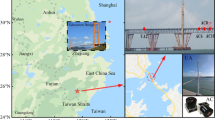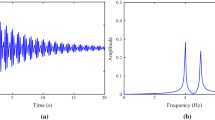Abstract
On one hand, when the bridge stays in a windy environment, the aerodynamic power would reduce it to act as a non-classic system. Consequently, the transposition of the system’s right eigenmatrix will not equal its left eigenmatrix any longer. On the other hand, eigenmatrix plays an important role in model identification, which is the basis of the identification of aerodynamic derivatives. In this study, we follow Scanlan’s simple bridge model and utilize the information provided by the left and right eigenmatrixes to structure a self-contained eigenvector algorithm in the frequency domain. For the purpose of fitting more accurate transfer function, the study adopts the combined sine-wave stimulation method in the numerical simulation. And from the simulation results, we can conclude that the derivatives identified by the self-contained eigenvector algorithm are more dependable.
Similar content being viewed by others
References
Scanlan R H, Sabzevari A. Experimental aerodynamic coefficients in the analytical study of suspension bridge flutter. J Mechl Eng Sci, 1969, 11(3): 1–11
Scanlan R H, Tomko J J. Airfoil and bridge deck flutter derivatives. J Eng Mech Div, 1971, 97(6): 1717–1737
Sarkar P P. New identification method applied to the response of flexible bridge to wind. PhD Thesis. Baltimore: The Johns Hopkins 1992
Jakobsen J B, Hansen E H. Determination of the aerodynamic derivatives by a system identification method. J Wind Eng Indust Aerodyn, 1995, 57: 295–305
Iwamoto M, Fujino Y. Identification of flutter derivatives of bridge deck from free vibration data. J Wind Eng Indust Aerodyn, 1995, 54–55: 55–63
Shirai S, Ueda T. Aerodynamic simulation by CFD on flat box grider of super-long-span suspension bridge. J Wind Eng Indust Aerodyn, 2003, 91: 279–290
Savage M G, Larose G L. An experimental study of the aerodynamic influence of a pair of winglets on a flat plate model. J Wind Eng Indust Aerodyn, 2003, 91: 113–126
Gu M, Zhang R X, Xiang H F. Identification of flutter derivatives of bridge decks. J Wind Eng Indust Aerodyn, 2000, 84: 151–162
Gu M, Zhang R X, Xiang H F. Parametric study on flutter derivatives of bridge decks. Eng Struct, 2001, 23: 1607–1613
Gu M, Qin X R. Direct identification of flutter derivatives and aerodynamic admittances of bridge decks. Eng Struct, 2004, 26: 2161–2172
Bartoli G, Righi M. Flutter mechanism for rectangular prisms in smooth and turbulent flow. J Wind Eng Indust Aerodyn, 2006, 94: 75–291
Cigada A, Diana G, Zappa E. On the response of a bridge deck to turbulent wind: A new approach. J Wind Eng Indust Aerodyn, 2002, 90: 1173–1182
Zhang X J, Xiang H F, Sun B N. Nonlinear aerostatic and aerodynamic analysis of long-span suspension bridges considering wind-structure interactions. J Wind Eng Indust Aerodyn, 2002, 90: 1065–1080
Diana G, Rocchi D, Argentini T, et al. Aerodynamic instability of a bridge deck section model: Linear and nonlinear approach to force modeling. J Wind Eng Indust Aerodyn, 2010, 98: 363–374
Gustavsen B, Semlyen A. Rational approximation of frequency domain responses by vector fitting. IEEE Trans Power Delivery, 1999, 14(3): 1052–1061
Ibrahim S R, Mikulcik E C. A method for the direct identification of vibration parameters from the free response. Shock Vib Bull, 1977, 47: 183–198
Zhang X X, Chen L F, Song H W. Combined sine-wave method of stimulation for the experiment of bridge model (in Chinese). J Vib Shock, 2009, 28(12): 136–139
Author information
Authors and Affiliations
Corresponding author
Rights and permissions
About this article
Cite this article
Zhang, X., Chen, L. & Song, H. Self-contained eigenvector algorithm applied to the identification of aerodynamic derivatives of bridge model. Sci. China Technol. Sci. 54, 1134–1140 (2011). https://doi.org/10.1007/s11431-011-4343-y
Received:
Accepted:
Published:
Issue Date:
DOI: https://doi.org/10.1007/s11431-011-4343-y




